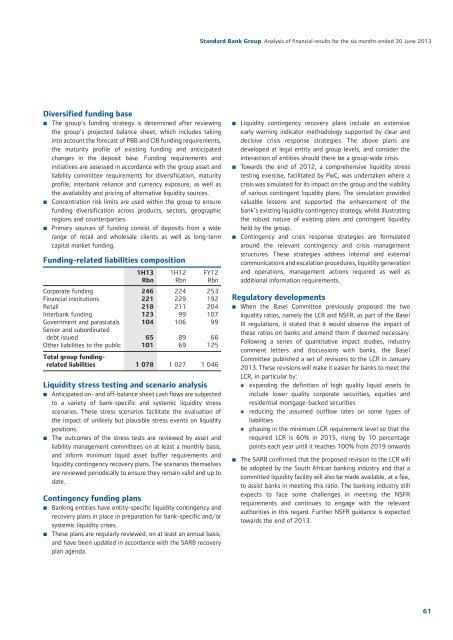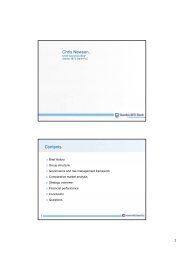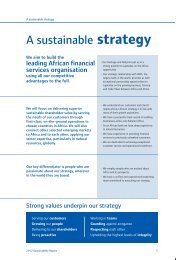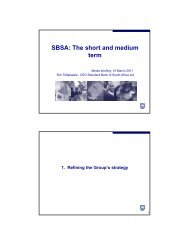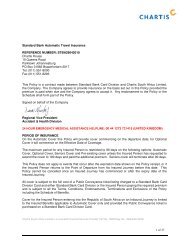Overview of financial results - Standard Bank - Investor Relations
Overview of financial results - Standard Bank - Investor Relations
Overview of financial results - Standard Bank - Investor Relations
You also want an ePaper? Increase the reach of your titles
YUMPU automatically turns print PDFs into web optimized ePapers that Google loves.
<strong>Standard</strong> <strong>Bank</strong> Group Analysis <strong>of</strong> <strong>financial</strong> <strong>results</strong> for the six months ended 30 June 2013<br />
Diversified funding base<br />
• The group’s funding strategy is determined after reviewing<br />
the group’s projected balance sheet, which includes taking<br />
into account the forecast <strong>of</strong> PBB and CIB funding requirements,<br />
the maturity pr<strong>of</strong>ile <strong>of</strong> existing funding and anticipated<br />
changes in the deposit base. Funding requirements and<br />
initiatives are assessed in accordance with the group asset and<br />
liability committee requirements for diversification, maturity<br />
pr<strong>of</strong>ile, interbank reliance and currency exposure, as well as<br />
the availability and pricing <strong>of</strong> alternative liquidity sources.<br />
• Concentration risk limits are used within the group to ensure<br />
funding diversification across products, sectors, geographic<br />
regions and counterparties.<br />
• Primary sources <strong>of</strong> funding consist <strong>of</strong> deposits from a wide<br />
range <strong>of</strong> retail and wholesale clients as well as long-term<br />
capital market funding.<br />
Funding-related liabilities composition<br />
1H13<br />
Rbn<br />
1H12<br />
Rbn<br />
FY12<br />
Rbn<br />
Corporate funding 246 224 253<br />
Financial institutions 221 229 192<br />
Retail 218 211 204<br />
Interbank funding 123 99 107<br />
Government and parastatals 104 106 99<br />
Senior and subordinated<br />
debt issued 65 89 66<br />
Other liabilities to the public 101 69 125<br />
Total group fundingrelated<br />
liabilities 1 078 1 027 1 046<br />
Liquidity stress testing and scenario analysis<br />
• Anticipated on- and <strong>of</strong>f-balance sheet cash flows are subjected<br />
to a variety <strong>of</strong> bank-specific and systemic liquidity stress<br />
scenarios. These stress scenarios facilitate the evaluation <strong>of</strong><br />
the impact <strong>of</strong> unlikely but plausible stress events on liquidity<br />
positions.<br />
• The outcomes <strong>of</strong> the stress tests are reviewed by asset and<br />
liability management committees on at least a monthly basis,<br />
and inform minimum liquid asset buffer requirements and<br />
liquidity contingency recovery plans. The scenarios themselves<br />
are reviewed periodically to ensure they remain valid and up to<br />
date.<br />
Contingency funding plans<br />
• <strong>Bank</strong>ing entities have entity-specific liquidity contingency and<br />
recovery plans in place in preparation for bank-specific and/or<br />
systemic liquidity crises.<br />
• These plans are regularly reviewed, on at least an annual basis,<br />
and have been updated in accordance with the SARB recovery<br />
plan agenda.<br />
• Liquidity contingency recovery plans include an extensive<br />
early warning indicator methodology supported by clear and<br />
decisive crisis response strategies. The above plans are<br />
developed at legal entity and group levels, and consider the<br />
interaction <strong>of</strong> entities should there be a group-wide crisis.<br />
• Towards the end <strong>of</strong> 2012, a comprehensive liquidity stress<br />
testing exercise, facilitated by PwC, was undertaken where a<br />
crisis was simulated for its impact on the group and the viability<br />
<strong>of</strong> various contingent liquidity plans. The simulation provided<br />
valuable lessons and supported the enhancement <strong>of</strong> the<br />
bank’s existing liquidity contingency strategy, whilst illustrating<br />
the robust nature <strong>of</strong> existing plans and contingent liquidity<br />
held by the group.<br />
• Contingency and crisis response strategies are formulated<br />
around the relevant contingency and crisis management<br />
structures. These strategies address internal and external<br />
communications and escalation procedures, liquidity generation<br />
and operations, management actions required as well as<br />
additional information requirements.<br />
Regulatory developments<br />
• When the Basel Committee previously proposed the two<br />
liquidity ratios, namely the LCR and NSFR, as part <strong>of</strong> the Basel<br />
III regulations, it stated that it would observe the impact <strong>of</strong><br />
these ratios on banks and amend them if deemed necessary.<br />
Following a series <strong>of</strong> quantitative impact studies, industry<br />
comment letters and discussions with banks, the Basel<br />
Committee published a set <strong>of</strong> revisions to the LCR in January<br />
2013. These revisions will make it easier for banks to meet the<br />
LCR, in particular by:<br />
• expanding the definition <strong>of</strong> high quality liquid assets to<br />
include lower quality corporate securities, equities and<br />
residential mortgage-backed securities<br />
• reducing the assumed outflow rates on some types <strong>of</strong><br />
liabilities<br />
• phasing in the minimum LCR requirement level so that the<br />
required LCR is 60% in 2015, rising by 10 percentage<br />
points each year until it reaches 100% from 2019 onwards<br />
• The SARB confirmed that the proposed revision to the LCR will<br />
be adopted by the South African banking industry and that a<br />
committed liquidity facility will also be made available, at a fee,<br />
to assist banks in meeting this ratio. The banking industry still<br />
expects to face some challenges in meeting the NSFR<br />
requirements and continues to engage with the relevant<br />
authorities in this regard. Further NSFR guidance is expected<br />
towards the end <strong>of</strong> 2013.<br />
61


